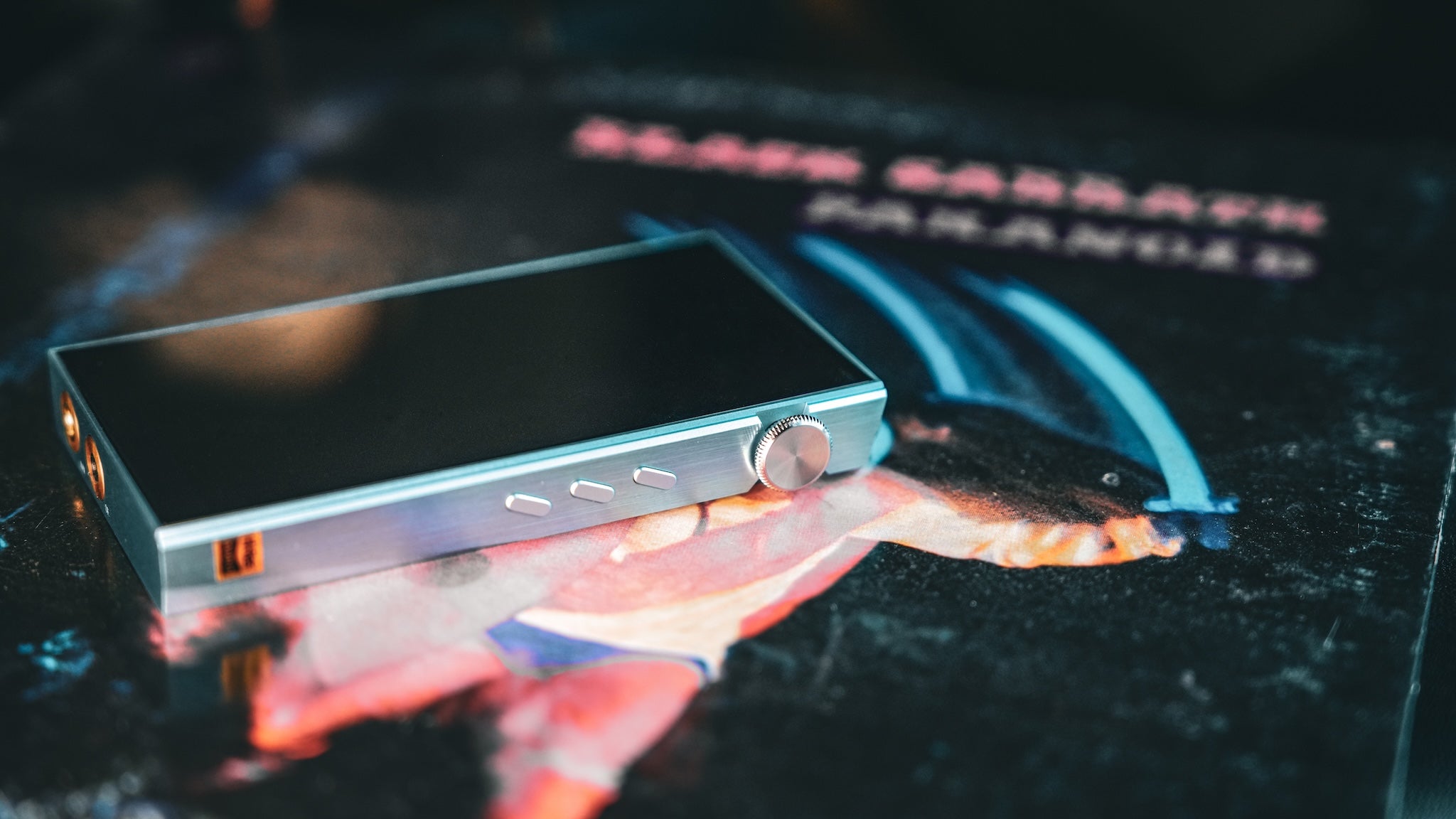“Entry-level” or “budget friendly” in the audiophile world doesn’t mean quite the same thing that it does for most electronics. At $479 for basic version and $529 for the upgraded version, the DX180 is the newest “entry level” HiFi digital audio player from iBasso, but $529 is quite a bit more than most premium portable consumer audio devices. Does DX180 provide an experience that’s good enough to warrant what looks like a premium price for the average music lover? And can it deliver sound and performance that make it worthwhile for seasoned audiophiles looking for a budget friendly portable option?
Build and Design
DX180’s package is similar to previous generations of iBasso players, with the device, case, charge cable, and screen protectors packed inside of an industry standard sort of box. The box isn’t anything special, but the device itself might turn a few heads, with some bolder curves and a more striking design than its predecessors. The build quality is solid, with physical buttons that feature a nice tactile click and a volume wheel with smooth action and just the right amount of physical feedback. iBasso has added a removable backplate to the device which allows for users to perform their own battery replacements, adding to the devices longevity.
The provided accessories get the job done nicely. There are five screen protectors, which seems like a very generous amount (especially since I never use them…) and the clear protective case looks just like the one from previous generations, which have done a great job protecting DX160 and DX170 from various drops and other forms of accidental destruction in our 4 years of using iBasso players. The USB-A to USB-C cable might seem a little dated as more brands switch to USB-C based chargers, but it’s great for those of us who still have a million USB-A charging bricks. You can also use any USB-C cable to charge the device, whether from a standard wall wart or with a PD3.0 or Q3.0 fast charging brick. It’s worth noting that DX180 has true “all day” battery life, with up to 15.5 hours of playback time.
For outputs, you get 3.5mm and 4.4mm jacks, along with the ability to switch the 3.5mm jack into S/PDIF mode to use a mini-coax connection. You can also output via the USB-C connection if you connect DX180 to an external DAC. For inputs, you can use DX180 as a Bluetooth DAC or a USB DAC. It does seem to be a little finicky about which cable you use for DAC mode, but it can work as a desktop DAC or as a portable DAC with your phone.
Using DX180
DX180’s user experience extends beyond a nice exterior. As soon as you turn it on, you’ll notice that it’s faster, smoother, and more responsive than most DAPs on the market right now – even some higher tier iBasso players and flagships from other brands. Another big plus is the Android 13 OS and the inclusion of the Google Play store. If you’re familiar with the audiophile DAP experience, often either side-loading apps, or selecting from a limited list is necessary, but DX180 takes down a big barrier to use, letting you download and use virtually any Android app right from the source.
The included Mango Player app serves as the default music player for the device, and also includes EQ options and playback settings. Some of the options are available both through the Android system and Mango Player, while others are only in Mango. These include DAC filters, the FIR filter, Gain levels, and Bluetooth DAC mode. The DAC filters offer subtle changes to the sound, with NOS (non-oversampling) being the most incisive option, and “Short Delay, Slow Roll-off” offering a slightly more relaxed presentation. The FIR filter enhances the utilization of the 4x DAC chips to perform additional audio processing in parallel, reducing noise and enhancing aspects of the devices imaging performance.
Bluetooth works well either as the input in DAC mode or for output to Bluetooth headphones or speakers, but the 5.0 is somewhat limiting. The lack of Bluetooth 5.2 or 5.3 is probably the biggest complaint that I’d have about the device as far as the features and general experience are concerned. As long as Bluetooth wasn’t your primary concern, the fact that this is the biggest complaint highlights just how good the device is overall.
Sound
iBasso’s players are known for a focus on detail and accuracy and DX180 keeps in line with that philosophy. Like DX170, it offers a little bit of a natural warmth and a strong dynamic delivery that keeps it from sounding sterile or clinical. Along with that, it presents a good sense of space and realism in the imaging, that’s three-dimensional and holographic, if not exceedingly wide or expansive.
DX180’s presentation of smaller details is one of its most surprising characteristics, given the price. The well-executed treble captures the right amount of sizzle and sparkle without sounding harsh, while the mids offer good fullness and body. The bass feels dynamic and impactful without any extra emphasis, and it extends linearly through the subbass offering plenty of depth and support for the low bass regions.
DX180 is a good pairing with a range of IEMs and easy to moderately hard to drive headphones. With the most sensitive of IEMs, you’ll probably pick up some light background interference, or very subtle waterfall noise, but on Low gain, DX180 will provide a low noise floor and great performance with a range of IEMs. DITA Project M and Moondrop Dark Saber were two of my favorite pairings during my listening time. For over-ear headphones, DX180 punches surprisingly hard with both high impedance dynamic headphones like the Sennheiser HD660S2 and with moderately hard to drive planars like the Meze Empyrean 2. DX180 might even work as a secondary option for the next tier up of hard to drive headphones like the Dan Clark E3.
Comparison: iBasso DX260, Astell&Kern SR35
If you’re looking to upgrade from a very basic setup, DX180’s price, sound, and simplicity make it a great pick, but if you’re looking at it as a more seasoned audiophile, the question remains of whether or not an entry-level product is enough to meet your more discerning audio needs. To answer that question, we brought in DX180’s big brother, the DX260, and the Astell&Kern SR35.
In terms of build and design DX180 and DX260 share a lot of DNA, but DX180 actually has a slight edge with a newer version of Android out of the box. DX260’s biggest advantage over the DX180 on the user side is its ability to boot into Mango OS, which gives users a very clean experience for listening to their music collection without any apps or additional load on the system. SR35 has a small edge in terms of materials, and – again – for users who are listening to a music collection they’ve downloaded and not streaming apps, but the smaller screen and quirkier design might be a turn off. Despite DX180’s strong battery life, SR35 pulls off a win there too, with a few more hours of listening per charge.
In terms of sound, all three offer something different. DX260 is the king of detail and resolution and rivals top tier players in its clarity and imaging. If you don’t want a strict reference sound, SR35 has one of the best tunings under $1000, with a sound that’s basically the brand’s flagship SP3000 without its insane levels of detail and resolution. DX180 offers something in between. In terms of sheer detail, DX180 exceeds what SR35 can offer, but its more revealing treble and more linear bass aren’t quite as musical as SR35. Compared to DX260, DX180 has a more engaging sound signature, but can’t match the level of holographic imaging and intricate detail that DX260 provides.
The Bottom Line
In terms of sound and performance, DX180 offers everything an audiophile needs for a mobile rig that won’t break the bank, but while I’ve heard great sounding DAPs that go for under $500 before, I’ve never used one with both that level of sound and performance and usability like DX180 – and that broadens the appeal for someone who is just getting their feet wet, or is more interested in the “cool gadget” aspect than the pure sound quality. Put it all together and DX180 makes a really compelling case for anyone who wants to enhance their portable audio experience.










